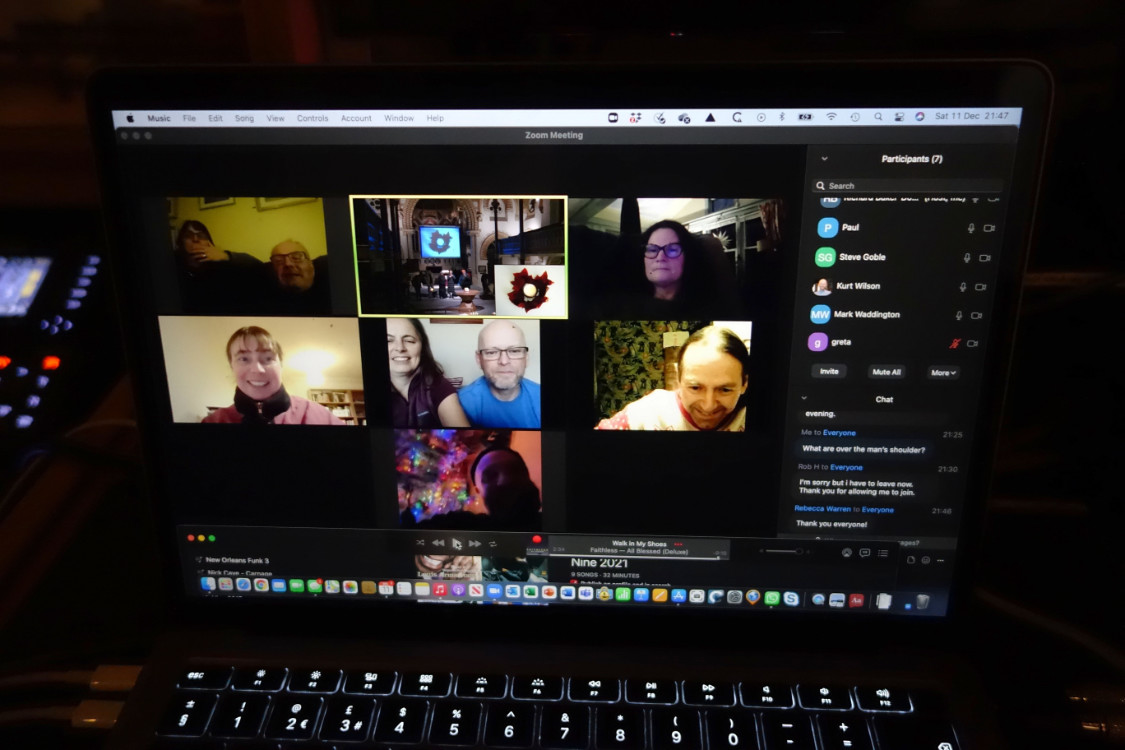December 2021: Nine
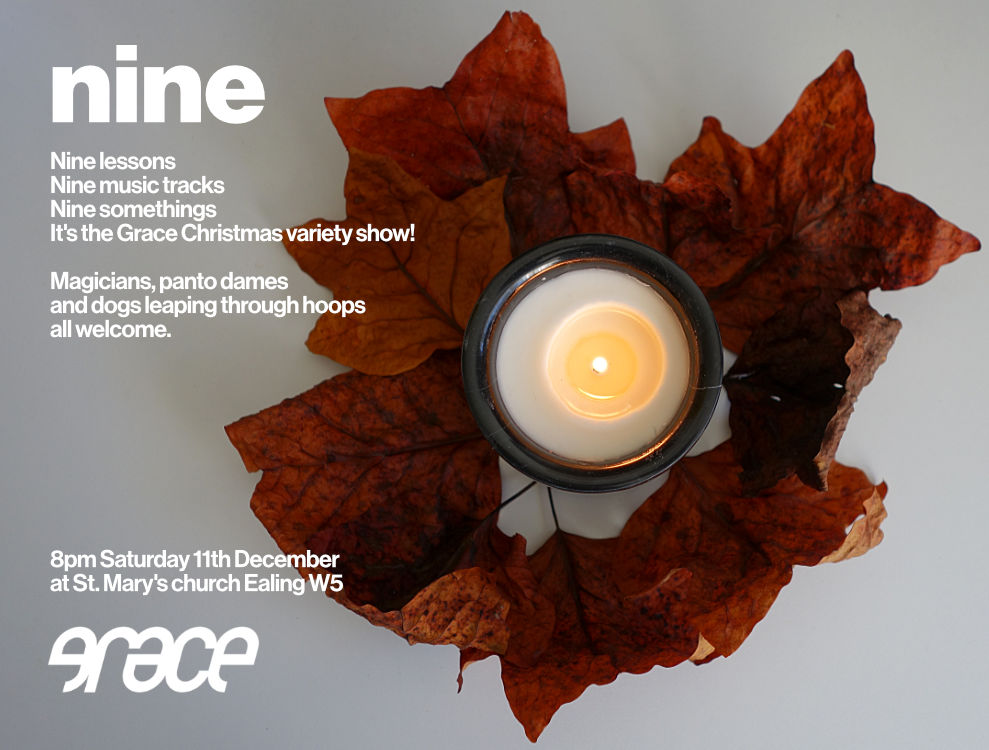
This was Grace's version of the traditional '9 lessons and carols' service. Essentially 9 people or groups have a reading to ‘do something with’ whether this be through art, a discussion, a presentation of some ideas, an activity to complete, a sermon (unlikely) - anything goes, together with a music track to complement the reading.
The readings were:
Lesson 1: The creation [Sue]
Genesis 1, vv 1-5, 26-8, 31
Track: What A Wonderful World, Louis Armstrong
Lesson 2: The fall [Steve]
Genesis 3, vv 8-15, 17-19
Track: Mercy Mercy Me (The Ecology), Marvin Gaye
Lesson 3: The people who walked in darkness... [Tony]
Isaiah 9, vv 2, 6, 7
Track: Everything Is Gonna Be Alright, Sounds of Blackness
Lesson 4: Isaiah's vision of the kingdom [Kurt]
Isaiah 11, vv 1-3a, 4a, 6-9
Track: La Hafla (feat. Sofiane Saidi), Acid Arab
Lesson 5: The Annunciation [Jen]
Luke 1, vv 26-35, 38
Track: Wait For Now (feat. Tawiah), The Cinematic Orchestra
Lesson 6: The Nativity [Richard]
Luke 2, vv 1, 3-7
Track: Driving Home For Christmas, Chris Rea
Lesson 7: The shepherds [Mike]
Luke 2, vv 8-16
Track: Weightless (Acoustic / Live at the Ritz), Elbow
Lesson 8: The Magi [Peter]
Matthew 2, vv 1-12
Track: Coventry Carol (feat. Maria Hansen), Sufjan Stevens
Lesson 9: The Word [Jonny]
John 1, vv 1-14
Track: Walk In My Shoes, Faithless
The slideshow for the service (pdf version) is here. It contains most of the words and images.
The Apple Music link for the playlist is here.
The Spotify link for the playlist is here.
Tony's reflections for lesson 3:
Then and Now
As we enter this season of Advent, let us remember the condition of the Jewish people 2000 years ago. The Romans had conquered Palestine and subjected the inhabitants to a set of foreign and often brutal rules. The conquerors did not respect, nor even understand, the religion and customs. People had lost their freedoms and when anyone tried to rise up in rebellion it was brutally put down.
Sound familiar? In the same area today there is oppression and lack of respect for beliefs and customs. Palestinians are subjected to brutality and their freedom of movement is limited. Family homes are demolished and when they try to rise up in rebellion it is brutally put down.
2000 years ago in the midst of that turmoil, a child came, born in a dingy, dirty stable. Out of those humble beginnings, a saviour was born. Because of that child we believe that love is stronger than fear, peace more enduring than hate, and that darkness will never put out the light. Because of that child, we dare to pray that injustice and oppression will end.
A time of quiet to pray for peace, freedom, justice and love in our world.
All – We are a people of hope, and this light is a reminder of that hope.
Tea lights were lit for those who we named in prayer
All – We are a people of hope and this light is a symbol of our prayer
Talk
We looked at John Ch. 7 and 8 where Jesus is at the Feast of Tabernacles. It was one of the three great pilgrimage festivals of the Jewish Year. The Feast lasted seven days, from the 15th to the 21st of the seventh month – Tishri, that is early October in our calendar. The festival took place at the end of the fruit harvest. The people lived for 7 days in shelters or tabernacles made of palm branches. It was an agricultural thanksgiving, but also a reminder of their ancestors' tent-dwelling days in the wilderness during the Exodus. It was a time of great rejoicing.
During the feast there were two very important events. The first was a great procession led by the priests to the Pool of Siloam to collect water which was ceremonially carried back to the Temple through the Water Gate, and then poured out. It was a vivid reminder of God's provision of water during the Exodus. It would have been at this point of the festival that Jesus said, "If anyone is thirsty, let him come to me and drink. Whoever believes in me, as the scripture has said, streams of living water will flow from within him." (John 7:37-38)
That was the first important ceremony in the Feast of Tabernacles which Jesus applied to Himself. The second was even more dramatic. The Feast actually went on for seven days and seven nights. To make this possible, each night four huge candelabra were erected in the Court of the Women to provide illumination for the whole Temple area. The candelabra were very large, the height of the Temple walls. The Temple itself was built on the highest point in the city of Jerusalem, so these huge flaming torches would have illuminated the whole city and probably way beyond its walls. It was then that Jesus stood up and said, "I am the light of the world, whoever follows me will never walk in darkness" (John 8:12).
Why is this statement of Jesus at this time so controversial? Firstly, he’s claiming to be God, because the light from the candelabra was seen as a reminder of the 'pillar of fire by night' which led the Israelites to the promised land. The lights at the feast were also associated with the great expectation of the coming Messiah. (Isaiah 62:1-3) So through this statement Jesus is saying that he is the Messiah!
So as Advent begins let the enormity of Jesus promise sink in, "I am the light of the world, whoever follows me will never walk in darkness, but will have the light of life..."
In this Advent season we await the coming of Christ Light of the World, come,
Come to the oppressed and exploited,
Come to the despised and rejected,
Come to all in whom the divine image is distorted.
We wait in joyful expectation.
Come not as a man of power, but in love and compassion,
Come to the outcast – like the shepherds in the fields,
Come to foreigners – like Magi watching from afar,
Come to rich and poor, young and old, male and female,
We wait in hopeful anticipation.
Come to bless all creation with your love,
Come to bring salvation on the earth,
Come to rule with justice and in peace.
Come Light of the World, illuminate our path.
We wait with all the peoples of the earth,
Light of the World we welcome your coming.
Jamboard for lesson 4:
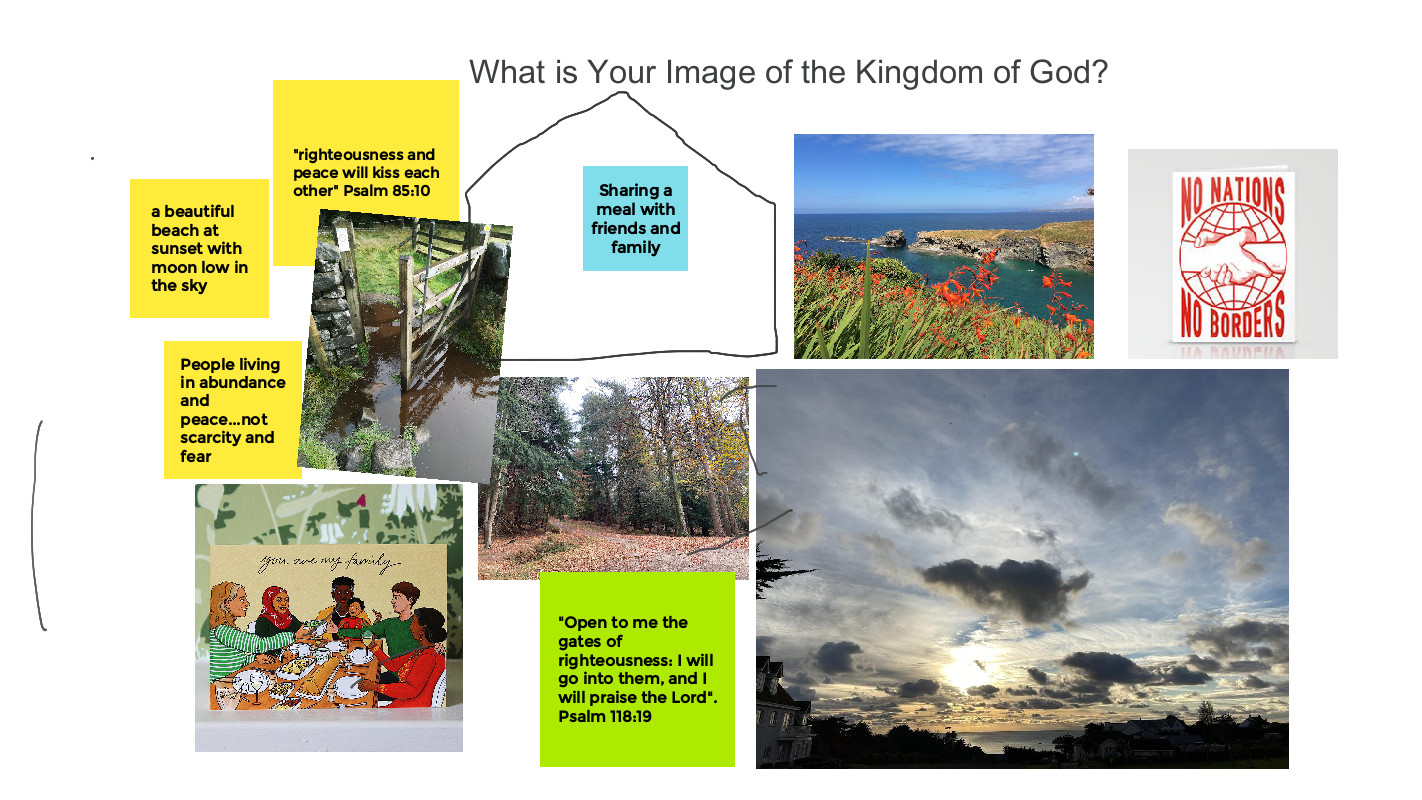
Richard's reflection for lesson 6:
The Nativity is frequently seen as a central image of Christmas and tries to equates this to a cosy image of the modern 'Christmas'.
The Nativity is not always presented in this light. The image on the screen of the sculpture by Tim Chalk created controversy when it was first erected for Christmas in 2003 and parallels were drawn to the displacement of families as refugees in the Iraq war.
So for Mary and Joseph the situation was not too dissimilar, they were in a country under occupation, the purpose of the census was not benign, it was for control and to raise taxes. As we can imagine they were travelling with many other people who were probably equally fearful and uncertain of what awaited them. We also know that in the near future they are going to have to flee to Egypt as refugees.
Some theologians attempt to describe the Nativity as an act of war against evil, yet if this is a very strange way start a war. The nativity is a demonstration of how God came among us and took on our vulnerabilities. It is more a disruptive insurgency, that over turns the existing values and assumptions of the world, an approach that Jesus was to follow through his life and death in challenging the status quo.
So while Christmas may seem cosy for us, we need to challenge ourselves to act like the Inn Keeper as a forerunner of the Good Samaritan and others that we encounter in the life of Jesus. Where could we make a difference this Christmas? How can we help those for whom home is fraught with difficulties, is not a safe space or who have no home to go to at all.
So in this track by Chris Rea we hear him sing about a joint experience of the modern 'Christmas' as a pilgrimage to the 'Holy Ground' that is the family and a thousand memories.
What are your images of the Nativity both personal and received? We are going to put a Jamboard to record them. If you can add them directly online then do so, otherwise put them on a post-it note and then add them on the laptop and screen that you will find in the café afterwards. We may then circulate a copy as part of the notes from the service.
Jamboard for lesson 6:

[Note: There were problems with accessing this in the service, which is why there are few entries]
Jonny's reflection for lesson 9:
I have been reading a book called ‘Rescuing The Gospel From The Cowboys’ by Richard Twiss. It is the result of research into the creative practice of followers of Jesus who are First Nations / Native American / American Indian who have embraced ways to worship that imaginatively have an at-homeness with their culture. So for example they meet in a sweat lodge, use tribal drums and music, share a pipe, use sage grass for prayer and cleansing rituals, use art and symbolism from their cultures, and use names for God as would be the tradition in their tribes such as Great Spirit. To us I suspect it is an absolute no brainer but it is nonetheless a hopeful movement and has taken 400 years to grow.
The cowboys are largely conservative evangelical white American Christians, who are the latest in a line from the white missionaries who shared the story of Jesus with their forebears, but in sharing that story sadly shared their own culture and in shocking ways made them turn away from their own cultural practices as evil. Now they would still see such practice as heretical or syncretistic. It is actually amazing anyone has remained a follower when to follow Christ has been presented in such foreign clothes as it were.
There is a new translation of the New Testament that came out in November called the First Nations Version which is in English but has been compiled through consulting people from many tribes in a long process. It felt to me very apt to read the last reading John ch 1 from this version. The reading famously has the line in it ‘the word became flesh and dwelt among us’ or ‘moved into the neighbourhood’ as the Message translates it, which is such an inspiring idea (the incarnation) - God makes God’s home inside our culture so there is an at-homeness to it.
As I read it there was an advent image from artist Scott Erickson (in slideshow). When I saw it I contacted him to ask about the image and what the First Nations representation had been inspired by to which he replied:
“The goal of the image was to make something that looked nothing like the heavily Western interpretations of this story. It has some influences from the Chinook and Salish tribes from the Pacific Northwest (where I grew up) but it also has influences from a Brazilian street artist, Russian modern iconographers, West African patterns, and Hindu iconography.”
I like it!
After the reading the music track was ‘Walk a mile in my shoes' by Faithless.
There are always Cowboys be they American missionaries, conservative evangelicals, Anglican or whatever. My sense in our own way, albeit without the genocide or centuries of oppression thank God, is that Grace has tried to rescue the gospel from the cowboys. May we continue to do so!
Technology
This service was our first hybrid event. Live webcast equipment had been installed in the church during the lockdowns. We used this to show the service in Zoom, and Kurt in Denver was able to speak to us via Zoom for his section.
We ran the Zoom meeting and the sound from one laptop, and the visuals onto the big screen (including the jamboards on the internet) on another laptop. This was more manageable than running it all off one laptop, but it meant that we couldn't put Zoom participants onto the big screen. No doubt we will find a way of doing it. It tends to create an 'infinite recursion' visual feedback effect, because the screen is in the Zoom meeting, and the Zoom meeting is on the screen...
Here is Kurt's jamboard live on the internet, being cast onto the big screen via the 'Black Magic' box:
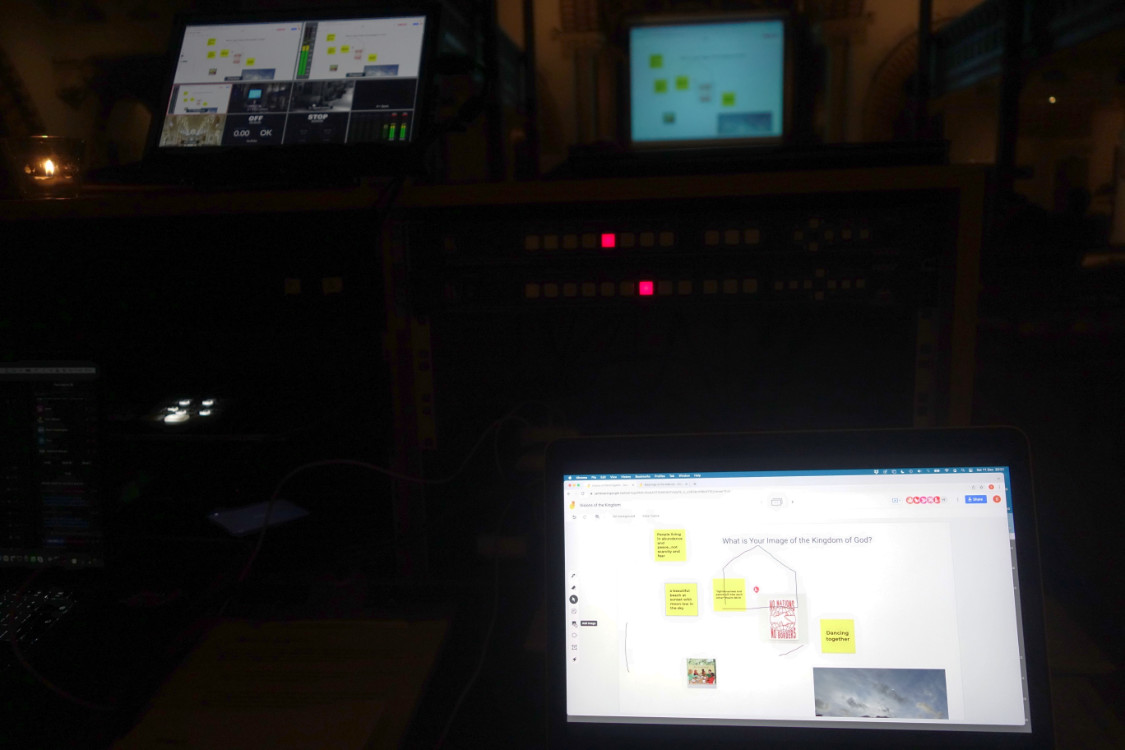
[It wasn't really that dark, it's exposed to show the screen content]
A view of the whole setup:
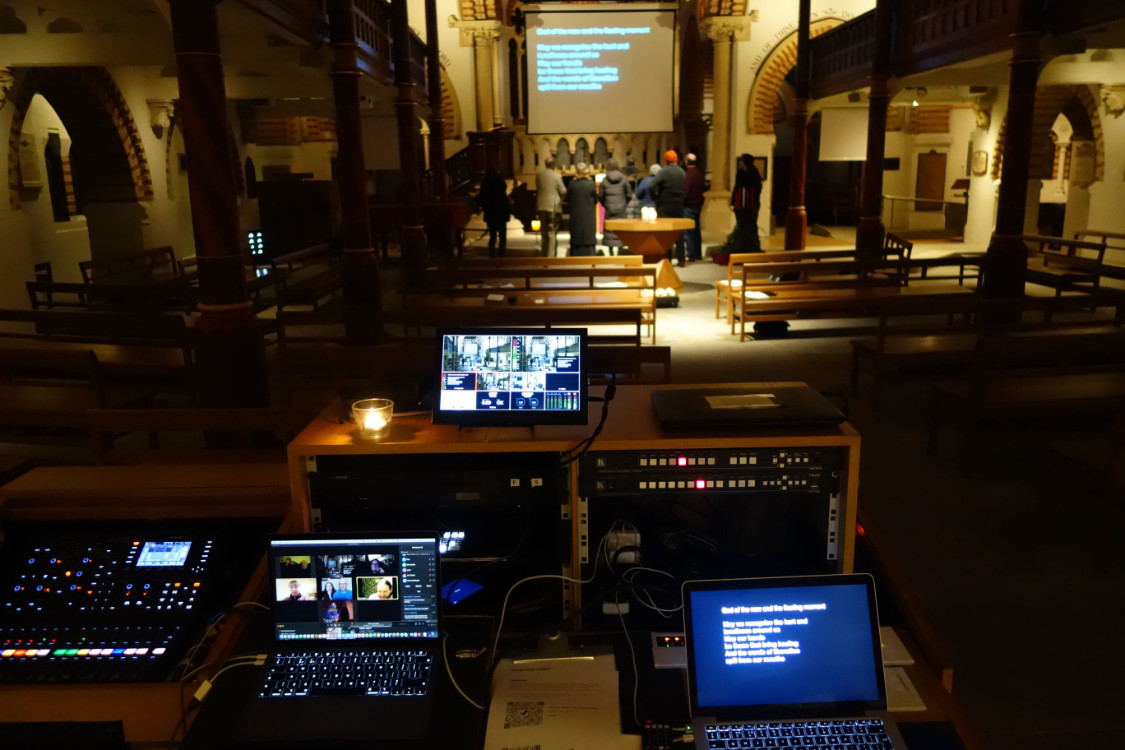
The laptop on the left is doing Zoom and music. The laptop on the right is doing everything that goes on the screen. The 'Black Magic' unit on top of the desk shows the cameras that are going out on Zoom. There is a remote to do camera close ups. Behind the left hand laptop is a set of illuminated buttons to choose between camera and slides or show both. We tried to keep it simple to start with ;-)
Below, a closeup of the Zoom meeting, at the end of the service. Everyone in the church went to the front for the final blessing to wave goodbye to the people on Zoom.
